Analysis: IFRS Adoption Impact on Thinly Capitalised Australian Firms
VerifiedAdded on 2021/05/31
|12
|3371
|39
Report
AI Summary
This report analyzes the impact of adopting International Financial Reporting Standards (IFRS) on the thinly capitalized positions of Australian companies. It begins with an overview of the adoption process, highlighting its significance and the resulting changes in financial reporting. The report explores the major consequences of IFRS adoption, including the impact on asset and liability valuations, debt-to-capital ratios, and potential tax implications. It details key differences between Generally Accepted Accounting Principles (GAAP) and IFRS rules, particularly concerning financial instruments, income taxes, and intangible assets. The analysis focuses on how these differences affect compliance with thin capitalization rules, potentially impacting tax deductions for interest payments. The report also examines the transitional periods and concerns raised by industry groups regarding the potential negative consequences of IFRS adoption on companies' tax positions, especially concerning their ability to deduct interest expenses. The report concludes by emphasizing the industry-specific impact of IFRS adoption and the adjustments companies may need to make to maintain compliance with thin capitalization provisions.
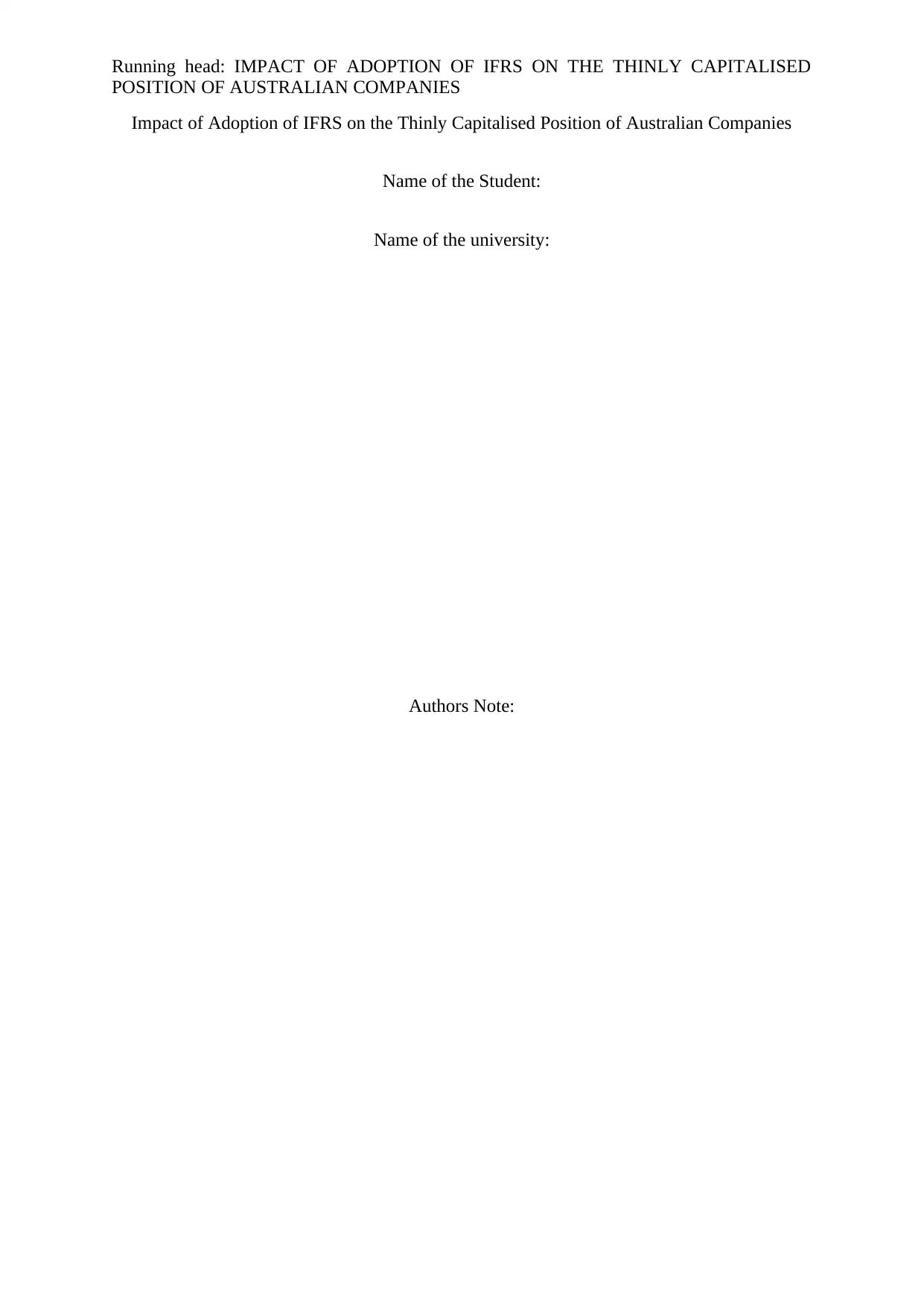
Running head: IMPACT OF ADOPTION OF IFRS ON THE THINLY CAPITALISED
POSITION OF AUSTRALIAN COMPANIES
Impact of Adoption of IFRS on the Thinly Capitalised Position of Australian Companies
Name of the Student:
Name of the university:
Authors Note:
POSITION OF AUSTRALIAN COMPANIES
Impact of Adoption of IFRS on the Thinly Capitalised Position of Australian Companies
Name of the Student:
Name of the university:
Authors Note:
Paraphrase This Document
Need a fresh take? Get an instant paraphrase of this document with our AI Paraphraser
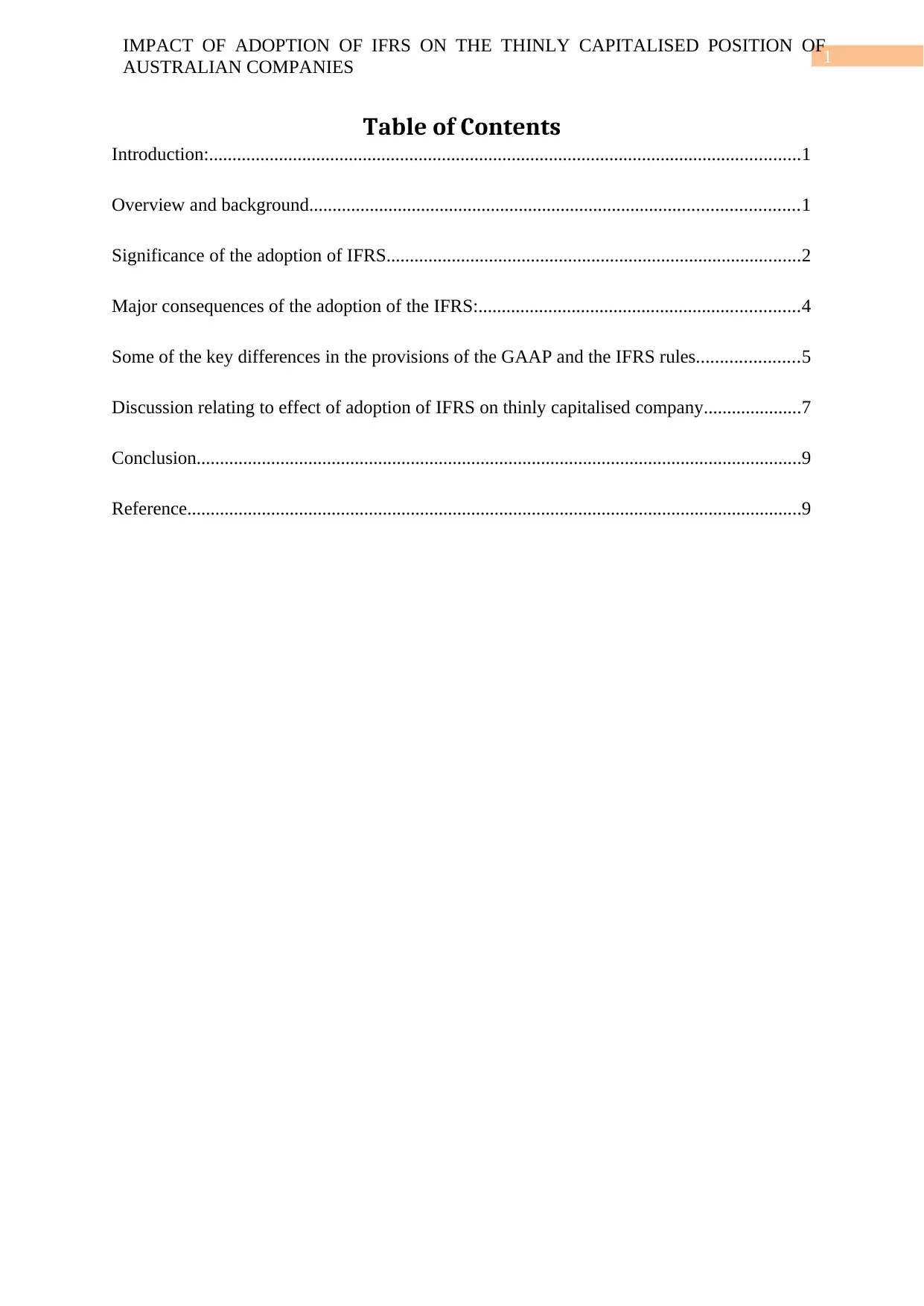
1
IMPACT OF ADOPTION OF IFRS ON THE THINLY CAPITALISED POSITION OF
AUSTRALIAN COMPANIES
Table of Contents
Introduction:...............................................................................................................................1
Overview and background.........................................................................................................1
Significance of the adoption of IFRS.........................................................................................2
Major consequences of the adoption of the IFRS:.....................................................................4
Some of the key differences in the provisions of the GAAP and the IFRS rules......................5
Discussion relating to effect of adoption of IFRS on thinly capitalised company.....................7
Conclusion..................................................................................................................................9
Reference....................................................................................................................................9
IMPACT OF ADOPTION OF IFRS ON THE THINLY CAPITALISED POSITION OF
AUSTRALIAN COMPANIES
Table of Contents
Introduction:...............................................................................................................................1
Overview and background.........................................................................................................1
Significance of the adoption of IFRS.........................................................................................2
Major consequences of the adoption of the IFRS:.....................................................................4
Some of the key differences in the provisions of the GAAP and the IFRS rules......................5
Discussion relating to effect of adoption of IFRS on thinly capitalised company.....................7
Conclusion..................................................................................................................................9
Reference....................................................................................................................................9
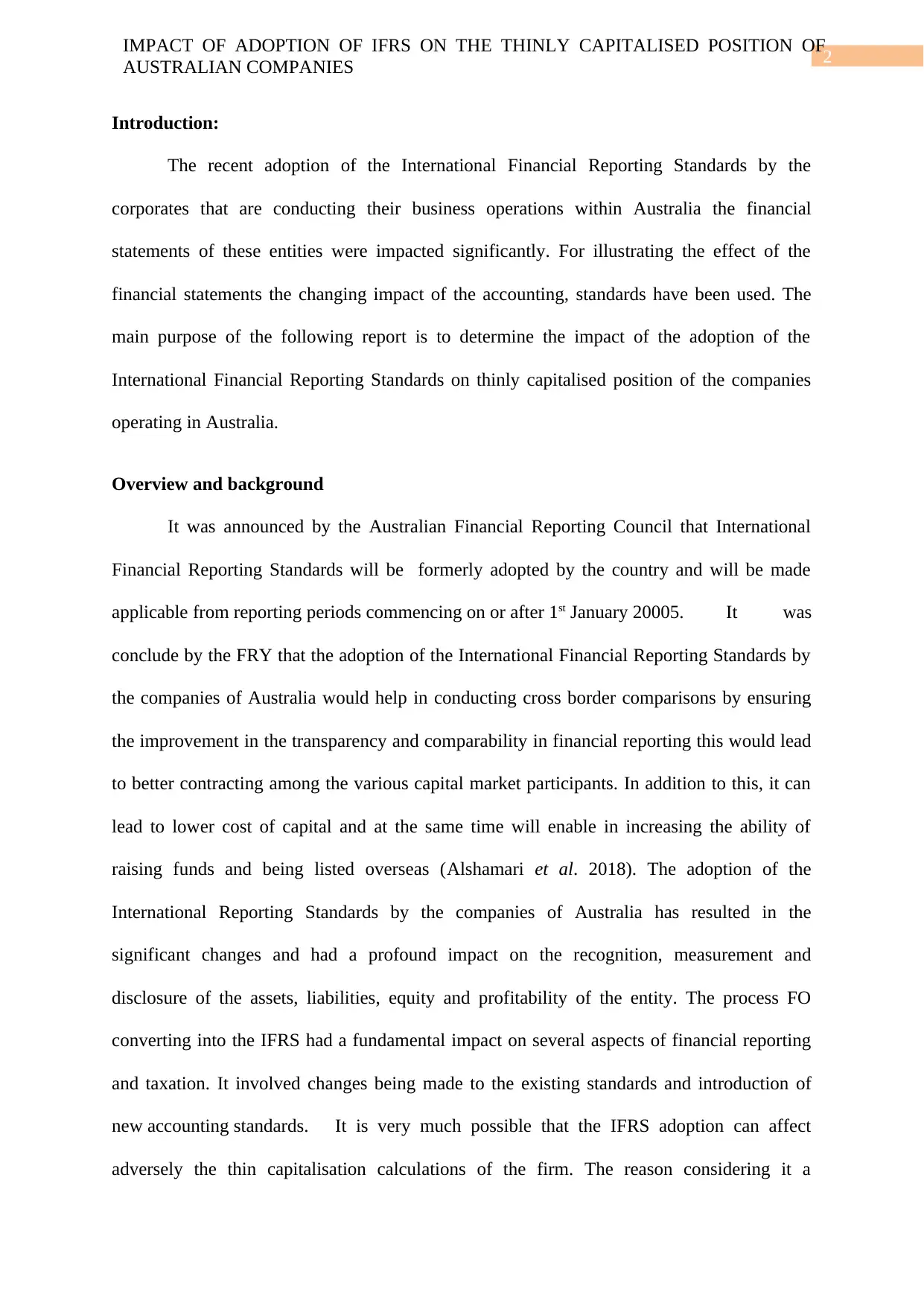
2
IMPACT OF ADOPTION OF IFRS ON THE THINLY CAPITALISED POSITION OF
AUSTRALIAN COMPANIES
Introduction:
The recent adoption of the International Financial Reporting Standards by the
corporates that are conducting their business operations within Australia the financial
statements of these entities were impacted significantly. For illustrating the effect of the
financial statements the changing impact of the accounting, standards have been used. The
main purpose of the following report is to determine the impact of the adoption of the
International Financial Reporting Standards on thinly capitalised position of the companies
operating in Australia.
Overview and background
It was announced by the Australian Financial Reporting Council that International
Financial Reporting Standards will be formerly adopted by the country and will be made
applicable from reporting periods commencing on or after 1st January 20005. It was
conclude by the FRY that the adoption of the International Financial Reporting Standards by
the companies of Australia would help in conducting cross border comparisons by ensuring
the improvement in the transparency and comparability in financial reporting this would lead
to better contracting among the various capital market participants. In addition to this, it can
lead to lower cost of capital and at the same time will enable in increasing the ability of
raising funds and being listed overseas (Alshamari et al. 2018). The adoption of the
International Reporting Standards by the companies of Australia has resulted in the
significant changes and had a profound impact on the recognition, measurement and
disclosure of the assets, liabilities, equity and profitability of the entity. The process FO
converting into the IFRS had a fundamental impact on several aspects of financial reporting
and taxation. It involved changes being made to the existing standards and introduction of
new accounting standards. It is very much possible that the IFRS adoption can affect
adversely the thin capitalisation calculations of the firm. The reason considering it a
IMPACT OF ADOPTION OF IFRS ON THE THINLY CAPITALISED POSITION OF
AUSTRALIAN COMPANIES
Introduction:
The recent adoption of the International Financial Reporting Standards by the
corporates that are conducting their business operations within Australia the financial
statements of these entities were impacted significantly. For illustrating the effect of the
financial statements the changing impact of the accounting, standards have been used. The
main purpose of the following report is to determine the impact of the adoption of the
International Financial Reporting Standards on thinly capitalised position of the companies
operating in Australia.
Overview and background
It was announced by the Australian Financial Reporting Council that International
Financial Reporting Standards will be formerly adopted by the country and will be made
applicable from reporting periods commencing on or after 1st January 20005. It was
conclude by the FRY that the adoption of the International Financial Reporting Standards by
the companies of Australia would help in conducting cross border comparisons by ensuring
the improvement in the transparency and comparability in financial reporting this would lead
to better contracting among the various capital market participants. In addition to this, it can
lead to lower cost of capital and at the same time will enable in increasing the ability of
raising funds and being listed overseas (Alshamari et al. 2018). The adoption of the
International Reporting Standards by the companies of Australia has resulted in the
significant changes and had a profound impact on the recognition, measurement and
disclosure of the assets, liabilities, equity and profitability of the entity. The process FO
converting into the IFRS had a fundamental impact on several aspects of financial reporting
and taxation. It involved changes being made to the existing standards and introduction of
new accounting standards. It is very much possible that the IFRS adoption can affect
adversely the thin capitalisation calculations of the firm. The reason considering it a
⊘ This is a preview!⊘
Do you want full access?
Subscribe today to unlock all pages.

Trusted by 1+ million students worldwide
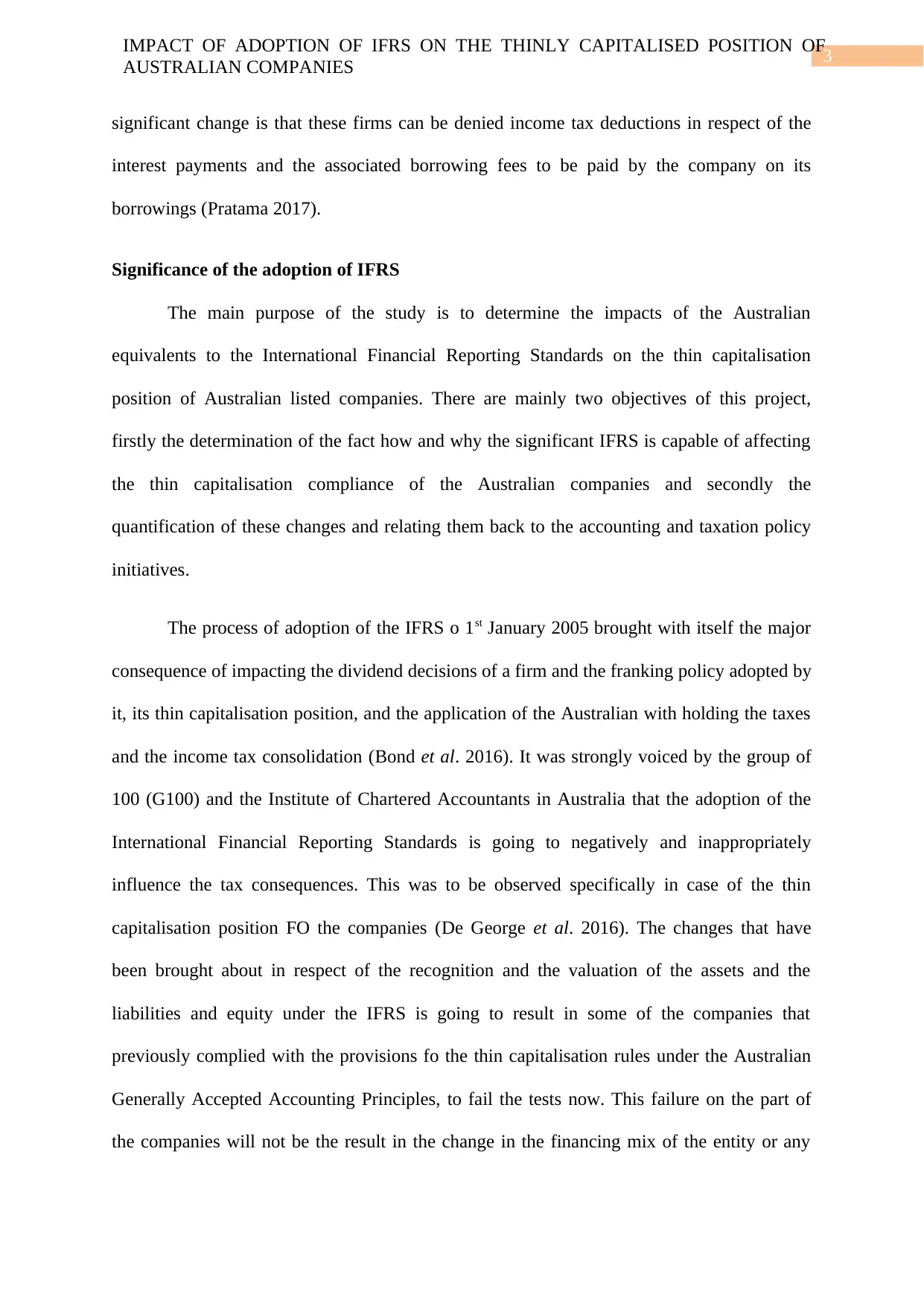
3
IMPACT OF ADOPTION OF IFRS ON THE THINLY CAPITALISED POSITION OF
AUSTRALIAN COMPANIES
significant change is that these firms can be denied income tax deductions in respect of the
interest payments and the associated borrowing fees to be paid by the company on its
borrowings (Pratama 2017).
Significance of the adoption of IFRS
The main purpose of the study is to determine the impacts of the Australian
equivalents to the International Financial Reporting Standards on the thin capitalisation
position of Australian listed companies. There are mainly two objectives of this project,
firstly the determination of the fact how and why the significant IFRS is capable of affecting
the thin capitalisation compliance of the Australian companies and secondly the
quantification of these changes and relating them back to the accounting and taxation policy
initiatives.
The process of adoption of the IFRS o 1st January 2005 brought with itself the major
consequence of impacting the dividend decisions of a firm and the franking policy adopted by
it, its thin capitalisation position, and the application of the Australian with holding the taxes
and the income tax consolidation (Bond et al. 2016). It was strongly voiced by the group of
100 (G100) and the Institute of Chartered Accountants in Australia that the adoption of the
International Financial Reporting Standards is going to negatively and inappropriately
influence the tax consequences. This was to be observed specifically in case of the thin
capitalisation position FO the companies (De George et al. 2016). The changes that have
been brought about in respect of the recognition and the valuation of the assets and the
liabilities and equity under the IFRS is going to result in some of the companies that
previously complied with the provisions fo the thin capitalisation rules under the Australian
Generally Accepted Accounting Principles, to fail the tests now. This failure on the part of
the companies will not be the result in the change in the financing mix of the entity or any
IMPACT OF ADOPTION OF IFRS ON THE THINLY CAPITALISED POSITION OF
AUSTRALIAN COMPANIES
significant change is that these firms can be denied income tax deductions in respect of the
interest payments and the associated borrowing fees to be paid by the company on its
borrowings (Pratama 2017).
Significance of the adoption of IFRS
The main purpose of the study is to determine the impacts of the Australian
equivalents to the International Financial Reporting Standards on the thin capitalisation
position of Australian listed companies. There are mainly two objectives of this project,
firstly the determination of the fact how and why the significant IFRS is capable of affecting
the thin capitalisation compliance of the Australian companies and secondly the
quantification of these changes and relating them back to the accounting and taxation policy
initiatives.
The process of adoption of the IFRS o 1st January 2005 brought with itself the major
consequence of impacting the dividend decisions of a firm and the franking policy adopted by
it, its thin capitalisation position, and the application of the Australian with holding the taxes
and the income tax consolidation (Bond et al. 2016). It was strongly voiced by the group of
100 (G100) and the Institute of Chartered Accountants in Australia that the adoption of the
International Financial Reporting Standards is going to negatively and inappropriately
influence the tax consequences. This was to be observed specifically in case of the thin
capitalisation position FO the companies (De George et al. 2016). The changes that have
been brought about in respect of the recognition and the valuation of the assets and the
liabilities and equity under the IFRS is going to result in some of the companies that
previously complied with the provisions fo the thin capitalisation rules under the Australian
Generally Accepted Accounting Principles, to fail the tests now. This failure on the part of
the companies will not be the result in the change in the financing mix of the entity or any
Paraphrase This Document
Need a fresh take? Get an instant paraphrase of this document with our AI Paraphraser

4
IMPACT OF ADOPTION OF IFRS ON THE THINLY CAPITALISED POSITION OF
AUSTRALIAN COMPANIES
changes in the business operations FO the entity but due to the compulsory compliance with
the IFRS.
After the introduction of the IFRS, it was directed by the Federal Treasurer to allow a
transitional period of three years period to 31 December 2007, under which the companies
had the option of electing on an annual basis, the use of IFRS or the GAAP, as they existed
pre-1st January 2005 for calculating their thin capitalisation position. It has been further
viciously argued by the G100 and Institute of Chartered Accountants in Australia that a
longer period is required for ensuring that the companies are not worse off under the
provisions of the thin capitalisation rules subsequent to the adoption of the IFRS than they
were prior to its adoption (Richardson and Taylor 2015).
Major consequences of the adoption of the IFRS:
The major consequences of the adoption of the IFRS are as follows:
a) As per the new provisions laid down by the IFRS, the entities will have to report
higher amounts of assets and liabilities as on the balance sheet date. For example, the
unrealised losses in respect of the derivative financial instruments will have to be
recorded as liabilities in the balance sheet and will have significant relevance of
determination of a net asset amount that will form part in the calculation of the thin
capitalisation calculations.
b) On an overall basis, there might be a reduction in the net asset position of the entity.
The reason for this is that the net asset position of the company is going to be
subjected to a greater volatility that was not being previously encountered under the
provisions of GAAP (Conaway et al. 2017).
c) With the adoption of the fair value accounting under the provisions under IFRS it is
possible that certain assets, liabilities and the equity that is not at present recognised
IMPACT OF ADOPTION OF IFRS ON THE THINLY CAPITALISED POSITION OF
AUSTRALIAN COMPANIES
changes in the business operations FO the entity but due to the compulsory compliance with
the IFRS.
After the introduction of the IFRS, it was directed by the Federal Treasurer to allow a
transitional period of three years period to 31 December 2007, under which the companies
had the option of electing on an annual basis, the use of IFRS or the GAAP, as they existed
pre-1st January 2005 for calculating their thin capitalisation position. It has been further
viciously argued by the G100 and Institute of Chartered Accountants in Australia that a
longer period is required for ensuring that the companies are not worse off under the
provisions of the thin capitalisation rules subsequent to the adoption of the IFRS than they
were prior to its adoption (Richardson and Taylor 2015).
Major consequences of the adoption of the IFRS:
The major consequences of the adoption of the IFRS are as follows:
a) As per the new provisions laid down by the IFRS, the entities will have to report
higher amounts of assets and liabilities as on the balance sheet date. For example, the
unrealised losses in respect of the derivative financial instruments will have to be
recorded as liabilities in the balance sheet and will have significant relevance of
determination of a net asset amount that will form part in the calculation of the thin
capitalisation calculations.
b) On an overall basis, there might be a reduction in the net asset position of the entity.
The reason for this is that the net asset position of the company is going to be
subjected to a greater volatility that was not being previously encountered under the
provisions of GAAP (Conaway et al. 2017).
c) With the adoption of the fair value accounting under the provisions under IFRS it is
possible that certain assets, liabilities and the equity that is not at present recognised
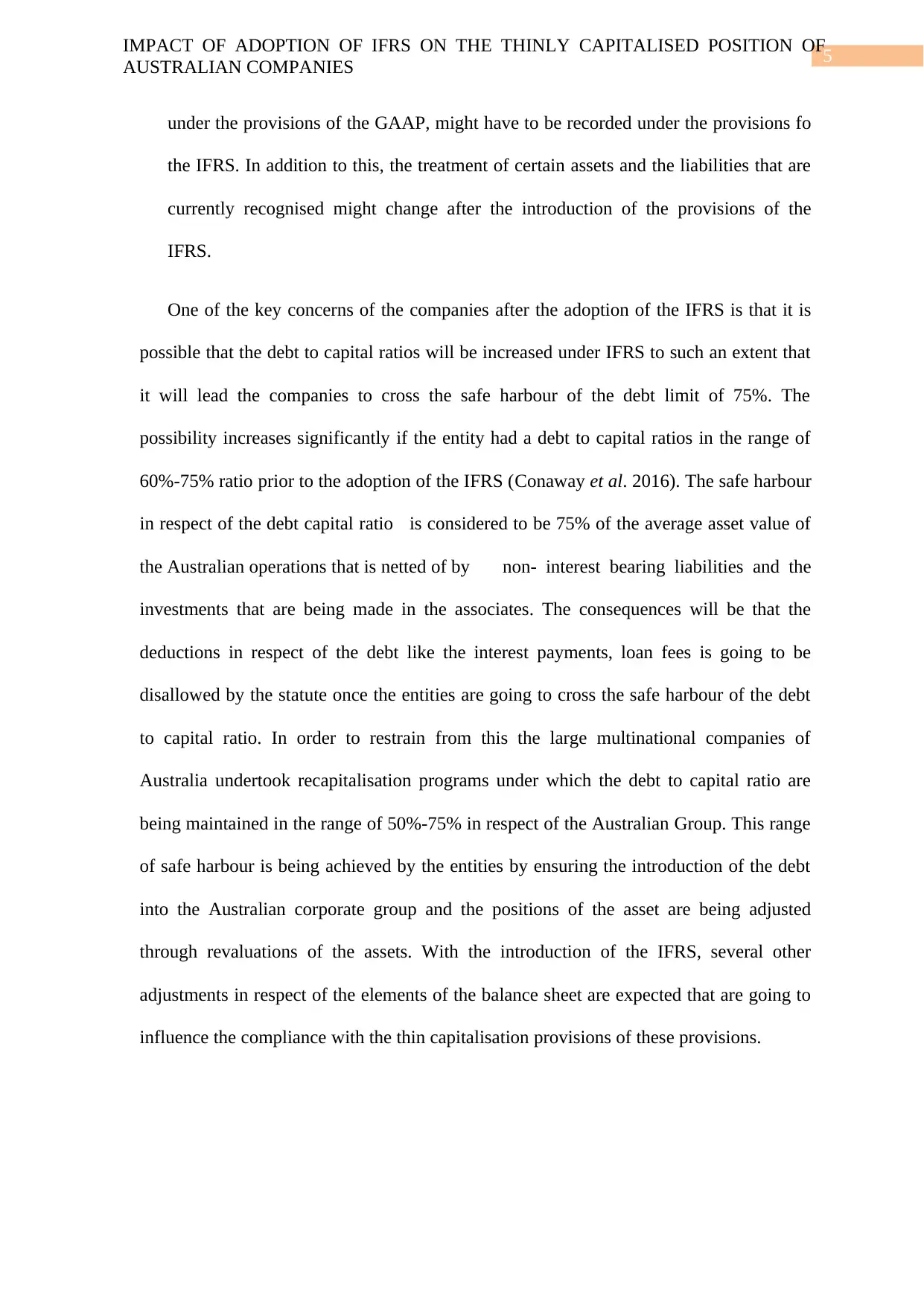
5
IMPACT OF ADOPTION OF IFRS ON THE THINLY CAPITALISED POSITION OF
AUSTRALIAN COMPANIES
under the provisions of the GAAP, might have to be recorded under the provisions fo
the IFRS. In addition to this, the treatment of certain assets and the liabilities that are
currently recognised might change after the introduction of the provisions of the
IFRS.
One of the key concerns of the companies after the adoption of the IFRS is that it is
possible that the debt to capital ratios will be increased under IFRS to such an extent that
it will lead the companies to cross the safe harbour of the debt limit of 75%. The
possibility increases significantly if the entity had a debt to capital ratios in the range of
60%-75% ratio prior to the adoption of the IFRS (Conaway et al. 2016). The safe harbour
in respect of the debt capital ratio is considered to be 75% of the average asset value of
the Australian operations that is netted of by non- interest bearing liabilities and the
investments that are being made in the associates. The consequences will be that the
deductions in respect of the debt like the interest payments, loan fees is going to be
disallowed by the statute once the entities are going to cross the safe harbour of the debt
to capital ratio. In order to restrain from this the large multinational companies of
Australia undertook recapitalisation programs under which the debt to capital ratio are
being maintained in the range of 50%-75% in respect of the Australian Group. This range
of safe harbour is being achieved by the entities by ensuring the introduction of the debt
into the Australian corporate group and the positions of the asset are being adjusted
through revaluations of the assets. With the introduction of the IFRS, several other
adjustments in respect of the elements of the balance sheet are expected that are going to
influence the compliance with the thin capitalisation provisions of these provisions.
IMPACT OF ADOPTION OF IFRS ON THE THINLY CAPITALISED POSITION OF
AUSTRALIAN COMPANIES
under the provisions of the GAAP, might have to be recorded under the provisions fo
the IFRS. In addition to this, the treatment of certain assets and the liabilities that are
currently recognised might change after the introduction of the provisions of the
IFRS.
One of the key concerns of the companies after the adoption of the IFRS is that it is
possible that the debt to capital ratios will be increased under IFRS to such an extent that
it will lead the companies to cross the safe harbour of the debt limit of 75%. The
possibility increases significantly if the entity had a debt to capital ratios in the range of
60%-75% ratio prior to the adoption of the IFRS (Conaway et al. 2016). The safe harbour
in respect of the debt capital ratio is considered to be 75% of the average asset value of
the Australian operations that is netted of by non- interest bearing liabilities and the
investments that are being made in the associates. The consequences will be that the
deductions in respect of the debt like the interest payments, loan fees is going to be
disallowed by the statute once the entities are going to cross the safe harbour of the debt
to capital ratio. In order to restrain from this the large multinational companies of
Australia undertook recapitalisation programs under which the debt to capital ratio are
being maintained in the range of 50%-75% in respect of the Australian Group. This range
of safe harbour is being achieved by the entities by ensuring the introduction of the debt
into the Australian corporate group and the positions of the asset are being adjusted
through revaluations of the assets. With the introduction of the IFRS, several other
adjustments in respect of the elements of the balance sheet are expected that are going to
influence the compliance with the thin capitalisation provisions of these provisions.
⊘ This is a preview!⊘
Do you want full access?
Subscribe today to unlock all pages.

Trusted by 1+ million students worldwide
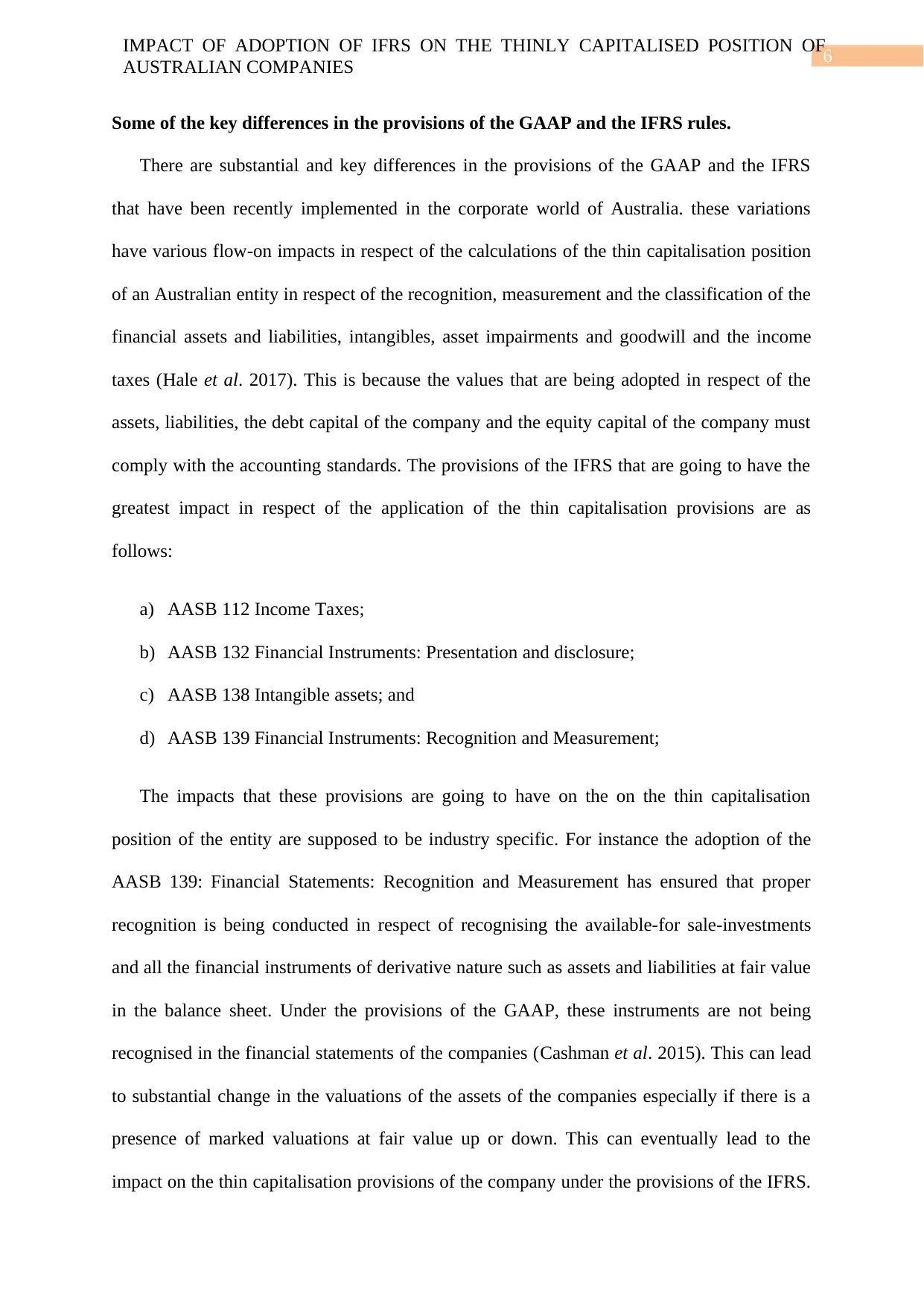
6
IMPACT OF ADOPTION OF IFRS ON THE THINLY CAPITALISED POSITION OF
AUSTRALIAN COMPANIES
Some of the key differences in the provisions of the GAAP and the IFRS rules.
There are substantial and key differences in the provisions of the GAAP and the IFRS
that have been recently implemented in the corporate world of Australia. these variations
have various flow-on impacts in respect of the calculations of the thin capitalisation position
of an Australian entity in respect of the recognition, measurement and the classification of the
financial assets and liabilities, intangibles, asset impairments and goodwill and the income
taxes (Hale et al. 2017). This is because the values that are being adopted in respect of the
assets, liabilities, the debt capital of the company and the equity capital of the company must
comply with the accounting standards. The provisions of the IFRS that are going to have the
greatest impact in respect of the application of the thin capitalisation provisions are as
follows:
a) AASB 112 Income Taxes;
b) AASB 132 Financial Instruments: Presentation and disclosure;
c) AASB 138 Intangible assets; and
d) AASB 139 Financial Instruments: Recognition and Measurement;
The impacts that these provisions are going to have on the on the thin capitalisation
position of the entity are supposed to be industry specific. For instance the adoption of the
AASB 139: Financial Statements: Recognition and Measurement has ensured that proper
recognition is being conducted in respect of recognising the available-for sale-investments
and all the financial instruments of derivative nature such as assets and liabilities at fair value
in the balance sheet. Under the provisions of the GAAP, these instruments are not being
recognised in the financial statements of the companies (Cashman et al. 2015). This can lead
to substantial change in the valuations of the assets of the companies especially if there is a
presence of marked valuations at fair value up or down. This can eventually lead to the
impact on the thin capitalisation provisions of the company under the provisions of the IFRS.
IMPACT OF ADOPTION OF IFRS ON THE THINLY CAPITALISED POSITION OF
AUSTRALIAN COMPANIES
Some of the key differences in the provisions of the GAAP and the IFRS rules.
There are substantial and key differences in the provisions of the GAAP and the IFRS
that have been recently implemented in the corporate world of Australia. these variations
have various flow-on impacts in respect of the calculations of the thin capitalisation position
of an Australian entity in respect of the recognition, measurement and the classification of the
financial assets and liabilities, intangibles, asset impairments and goodwill and the income
taxes (Hale et al. 2017). This is because the values that are being adopted in respect of the
assets, liabilities, the debt capital of the company and the equity capital of the company must
comply with the accounting standards. The provisions of the IFRS that are going to have the
greatest impact in respect of the application of the thin capitalisation provisions are as
follows:
a) AASB 112 Income Taxes;
b) AASB 132 Financial Instruments: Presentation and disclosure;
c) AASB 138 Intangible assets; and
d) AASB 139 Financial Instruments: Recognition and Measurement;
The impacts that these provisions are going to have on the on the thin capitalisation
position of the entity are supposed to be industry specific. For instance the adoption of the
AASB 139: Financial Statements: Recognition and Measurement has ensured that proper
recognition is being conducted in respect of recognising the available-for sale-investments
and all the financial instruments of derivative nature such as assets and liabilities at fair value
in the balance sheet. Under the provisions of the GAAP, these instruments are not being
recognised in the financial statements of the companies (Cashman et al. 2015). This can lead
to substantial change in the valuations of the assets of the companies especially if there is a
presence of marked valuations at fair value up or down. This can eventually lead to the
impact on the thin capitalisation provisions of the company under the provisions of the IFRS.
Paraphrase This Document
Need a fresh take? Get an instant paraphrase of this document with our AI Paraphraser
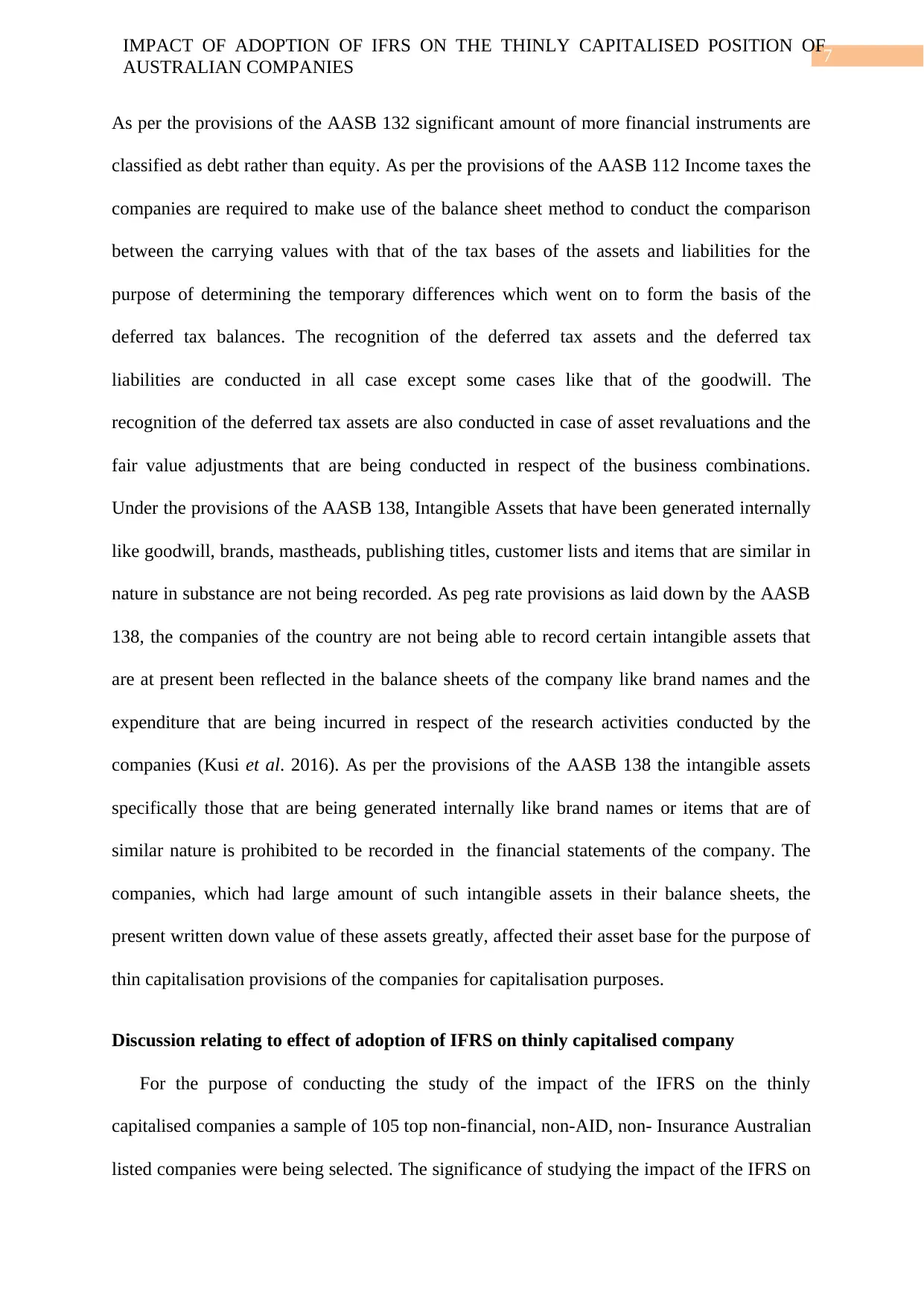
7
IMPACT OF ADOPTION OF IFRS ON THE THINLY CAPITALISED POSITION OF
AUSTRALIAN COMPANIES
As per the provisions of the AASB 132 significant amount of more financial instruments are
classified as debt rather than equity. As per the provisions of the AASB 112 Income taxes the
companies are required to make use of the balance sheet method to conduct the comparison
between the carrying values with that of the tax bases of the assets and liabilities for the
purpose of determining the temporary differences which went on to form the basis of the
deferred tax balances. The recognition of the deferred tax assets and the deferred tax
liabilities are conducted in all case except some cases like that of the goodwill. The
recognition of the deferred tax assets are also conducted in case of asset revaluations and the
fair value adjustments that are being conducted in respect of the business combinations.
Under the provisions of the AASB 138, Intangible Assets that have been generated internally
like goodwill, brands, mastheads, publishing titles, customer lists and items that are similar in
nature in substance are not being recorded. As peg rate provisions as laid down by the AASB
138, the companies of the country are not being able to record certain intangible assets that
are at present been reflected in the balance sheets of the company like brand names and the
expenditure that are being incurred in respect of the research activities conducted by the
companies (Kusi et al. 2016). As per the provisions of the AASB 138 the intangible assets
specifically those that are being generated internally like brand names or items that are of
similar nature is prohibited to be recorded in the financial statements of the company. The
companies, which had large amount of such intangible assets in their balance sheets, the
present written down value of these assets greatly, affected their asset base for the purpose of
thin capitalisation provisions of the companies for capitalisation purposes.
Discussion relating to effect of adoption of IFRS on thinly capitalised company
For the purpose of conducting the study of the impact of the IFRS on the thinly
capitalised companies a sample of 105 top non-financial, non-AID, non- Insurance Australian
listed companies were being selected. The significance of studying the impact of the IFRS on
IMPACT OF ADOPTION OF IFRS ON THE THINLY CAPITALISED POSITION OF
AUSTRALIAN COMPANIES
As per the provisions of the AASB 132 significant amount of more financial instruments are
classified as debt rather than equity. As per the provisions of the AASB 112 Income taxes the
companies are required to make use of the balance sheet method to conduct the comparison
between the carrying values with that of the tax bases of the assets and liabilities for the
purpose of determining the temporary differences which went on to form the basis of the
deferred tax balances. The recognition of the deferred tax assets and the deferred tax
liabilities are conducted in all case except some cases like that of the goodwill. The
recognition of the deferred tax assets are also conducted in case of asset revaluations and the
fair value adjustments that are being conducted in respect of the business combinations.
Under the provisions of the AASB 138, Intangible Assets that have been generated internally
like goodwill, brands, mastheads, publishing titles, customer lists and items that are similar in
nature in substance are not being recorded. As peg rate provisions as laid down by the AASB
138, the companies of the country are not being able to record certain intangible assets that
are at present been reflected in the balance sheets of the company like brand names and the
expenditure that are being incurred in respect of the research activities conducted by the
companies (Kusi et al. 2016). As per the provisions of the AASB 138 the intangible assets
specifically those that are being generated internally like brand names or items that are of
similar nature is prohibited to be recorded in the financial statements of the company. The
companies, which had large amount of such intangible assets in their balance sheets, the
present written down value of these assets greatly, affected their asset base for the purpose of
thin capitalisation provisions of the companies for capitalisation purposes.
Discussion relating to effect of adoption of IFRS on thinly capitalised company
For the purpose of conducting the study of the impact of the IFRS on the thinly
capitalised companies a sample of 105 top non-financial, non-AID, non- Insurance Australian
listed companies were being selected. The significance of studying the impact of the IFRS on
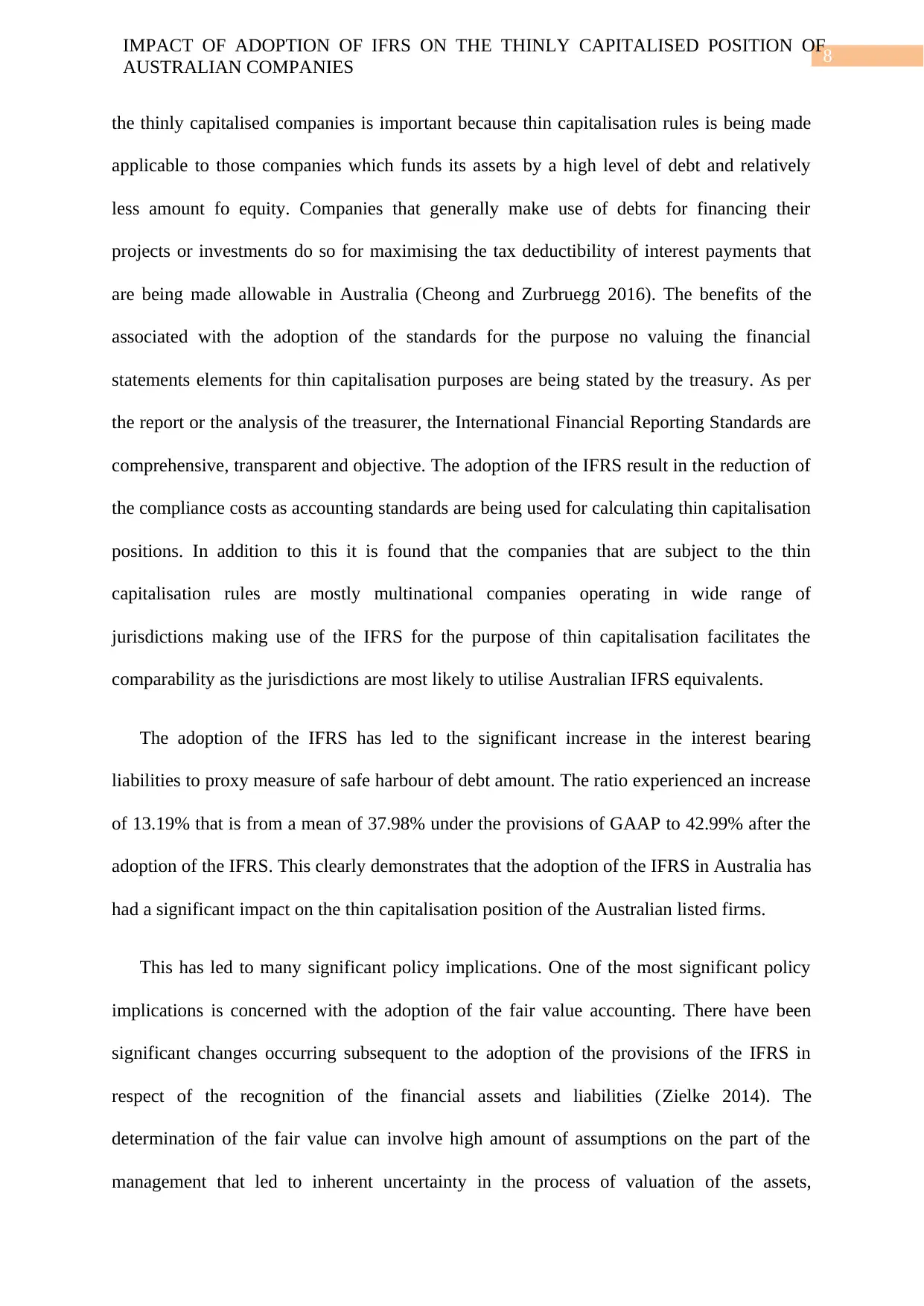
8
IMPACT OF ADOPTION OF IFRS ON THE THINLY CAPITALISED POSITION OF
AUSTRALIAN COMPANIES
the thinly capitalised companies is important because thin capitalisation rules is being made
applicable to those companies which funds its assets by a high level of debt and relatively
less amount fo equity. Companies that generally make use of debts for financing their
projects or investments do so for maximising the tax deductibility of interest payments that
are being made allowable in Australia (Cheong and Zurbruegg 2016). The benefits of the
associated with the adoption of the standards for the purpose no valuing the financial
statements elements for thin capitalisation purposes are being stated by the treasury. As per
the report or the analysis of the treasurer, the International Financial Reporting Standards are
comprehensive, transparent and objective. The adoption of the IFRS result in the reduction of
the compliance costs as accounting standards are being used for calculating thin capitalisation
positions. In addition to this it is found that the companies that are subject to the thin
capitalisation rules are mostly multinational companies operating in wide range of
jurisdictions making use of the IFRS for the purpose of thin capitalisation facilitates the
comparability as the jurisdictions are most likely to utilise Australian IFRS equivalents.
The adoption of the IFRS has led to the significant increase in the interest bearing
liabilities to proxy measure of safe harbour of debt amount. The ratio experienced an increase
of 13.19% that is from a mean of 37.98% under the provisions of GAAP to 42.99% after the
adoption of the IFRS. This clearly demonstrates that the adoption of the IFRS in Australia has
had a significant impact on the thin capitalisation position of the Australian listed firms.
This has led to many significant policy implications. One of the most significant policy
implications is concerned with the adoption of the fair value accounting. There have been
significant changes occurring subsequent to the adoption of the provisions of the IFRS in
respect of the recognition of the financial assets and liabilities (Zielke 2014). The
determination of the fair value can involve high amount of assumptions on the part of the
management that led to inherent uncertainty in the process of valuation of the assets,
IMPACT OF ADOPTION OF IFRS ON THE THINLY CAPITALISED POSITION OF
AUSTRALIAN COMPANIES
the thinly capitalised companies is important because thin capitalisation rules is being made
applicable to those companies which funds its assets by a high level of debt and relatively
less amount fo equity. Companies that generally make use of debts for financing their
projects or investments do so for maximising the tax deductibility of interest payments that
are being made allowable in Australia (Cheong and Zurbruegg 2016). The benefits of the
associated with the adoption of the standards for the purpose no valuing the financial
statements elements for thin capitalisation purposes are being stated by the treasury. As per
the report or the analysis of the treasurer, the International Financial Reporting Standards are
comprehensive, transparent and objective. The adoption of the IFRS result in the reduction of
the compliance costs as accounting standards are being used for calculating thin capitalisation
positions. In addition to this it is found that the companies that are subject to the thin
capitalisation rules are mostly multinational companies operating in wide range of
jurisdictions making use of the IFRS for the purpose of thin capitalisation facilitates the
comparability as the jurisdictions are most likely to utilise Australian IFRS equivalents.
The adoption of the IFRS has led to the significant increase in the interest bearing
liabilities to proxy measure of safe harbour of debt amount. The ratio experienced an increase
of 13.19% that is from a mean of 37.98% under the provisions of GAAP to 42.99% after the
adoption of the IFRS. This clearly demonstrates that the adoption of the IFRS in Australia has
had a significant impact on the thin capitalisation position of the Australian listed firms.
This has led to many significant policy implications. One of the most significant policy
implications is concerned with the adoption of the fair value accounting. There have been
significant changes occurring subsequent to the adoption of the provisions of the IFRS in
respect of the recognition of the financial assets and liabilities (Zielke 2014). The
determination of the fair value can involve high amount of assumptions on the part of the
management that led to inherent uncertainty in the process of valuation of the assets,
⊘ This is a preview!⊘
Do you want full access?
Subscribe today to unlock all pages.

Trusted by 1+ million students worldwide
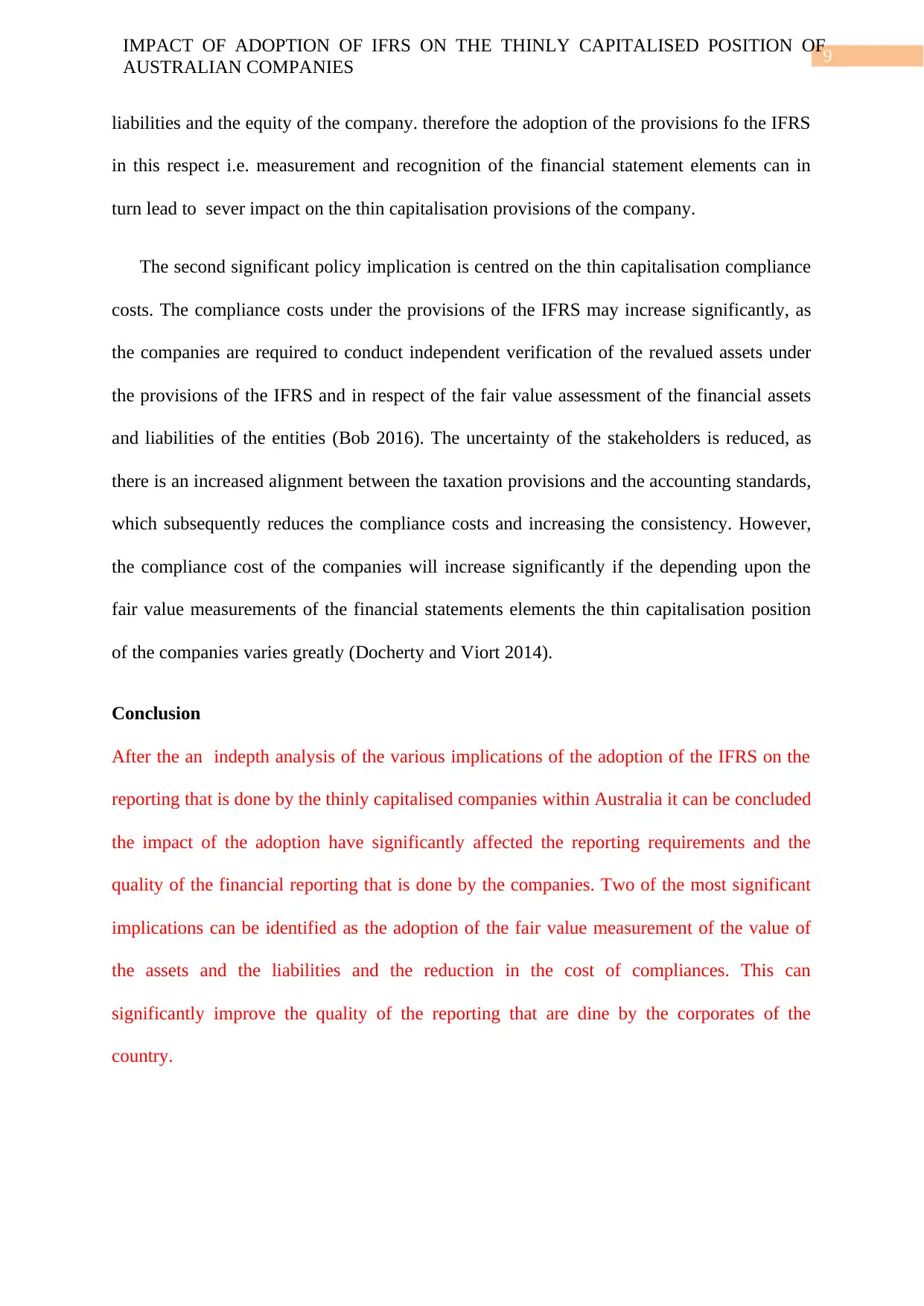
9
IMPACT OF ADOPTION OF IFRS ON THE THINLY CAPITALISED POSITION OF
AUSTRALIAN COMPANIES
liabilities and the equity of the company. therefore the adoption of the provisions fo the IFRS
in this respect i.e. measurement and recognition of the financial statement elements can in
turn lead to sever impact on the thin capitalisation provisions of the company.
The second significant policy implication is centred on the thin capitalisation compliance
costs. The compliance costs under the provisions of the IFRS may increase significantly, as
the companies are required to conduct independent verification of the revalued assets under
the provisions of the IFRS and in respect of the fair value assessment of the financial assets
and liabilities of the entities (Bob 2016). The uncertainty of the stakeholders is reduced, as
there is an increased alignment between the taxation provisions and the accounting standards,
which subsequently reduces the compliance costs and increasing the consistency. However,
the compliance cost of the companies will increase significantly if the depending upon the
fair value measurements of the financial statements elements the thin capitalisation position
of the companies varies greatly (Docherty and Viort 2014).
Conclusion
After the an indepth analysis of the various implications of the adoption of the IFRS on the
reporting that is done by the thinly capitalised companies within Australia it can be concluded
the impact of the adoption have significantly affected the reporting requirements and the
quality of the financial reporting that is done by the companies. Two of the most significant
implications can be identified as the adoption of the fair value measurement of the value of
the assets and the liabilities and the reduction in the cost of compliances. This can
significantly improve the quality of the reporting that are dine by the corporates of the
country.
IMPACT OF ADOPTION OF IFRS ON THE THINLY CAPITALISED POSITION OF
AUSTRALIAN COMPANIES
liabilities and the equity of the company. therefore the adoption of the provisions fo the IFRS
in this respect i.e. measurement and recognition of the financial statement elements can in
turn lead to sever impact on the thin capitalisation provisions of the company.
The second significant policy implication is centred on the thin capitalisation compliance
costs. The compliance costs under the provisions of the IFRS may increase significantly, as
the companies are required to conduct independent verification of the revalued assets under
the provisions of the IFRS and in respect of the fair value assessment of the financial assets
and liabilities of the entities (Bob 2016). The uncertainty of the stakeholders is reduced, as
there is an increased alignment between the taxation provisions and the accounting standards,
which subsequently reduces the compliance costs and increasing the consistency. However,
the compliance cost of the companies will increase significantly if the depending upon the
fair value measurements of the financial statements elements the thin capitalisation position
of the companies varies greatly (Docherty and Viort 2014).
Conclusion
After the an indepth analysis of the various implications of the adoption of the IFRS on the
reporting that is done by the thinly capitalised companies within Australia it can be concluded
the impact of the adoption have significantly affected the reporting requirements and the
quality of the financial reporting that is done by the companies. Two of the most significant
implications can be identified as the adoption of the fair value measurement of the value of
the assets and the liabilities and the reduction in the cost of compliances. This can
significantly improve the quality of the reporting that are dine by the corporates of the
country.
Paraphrase This Document
Need a fresh take? Get an instant paraphrase of this document with our AI Paraphraser
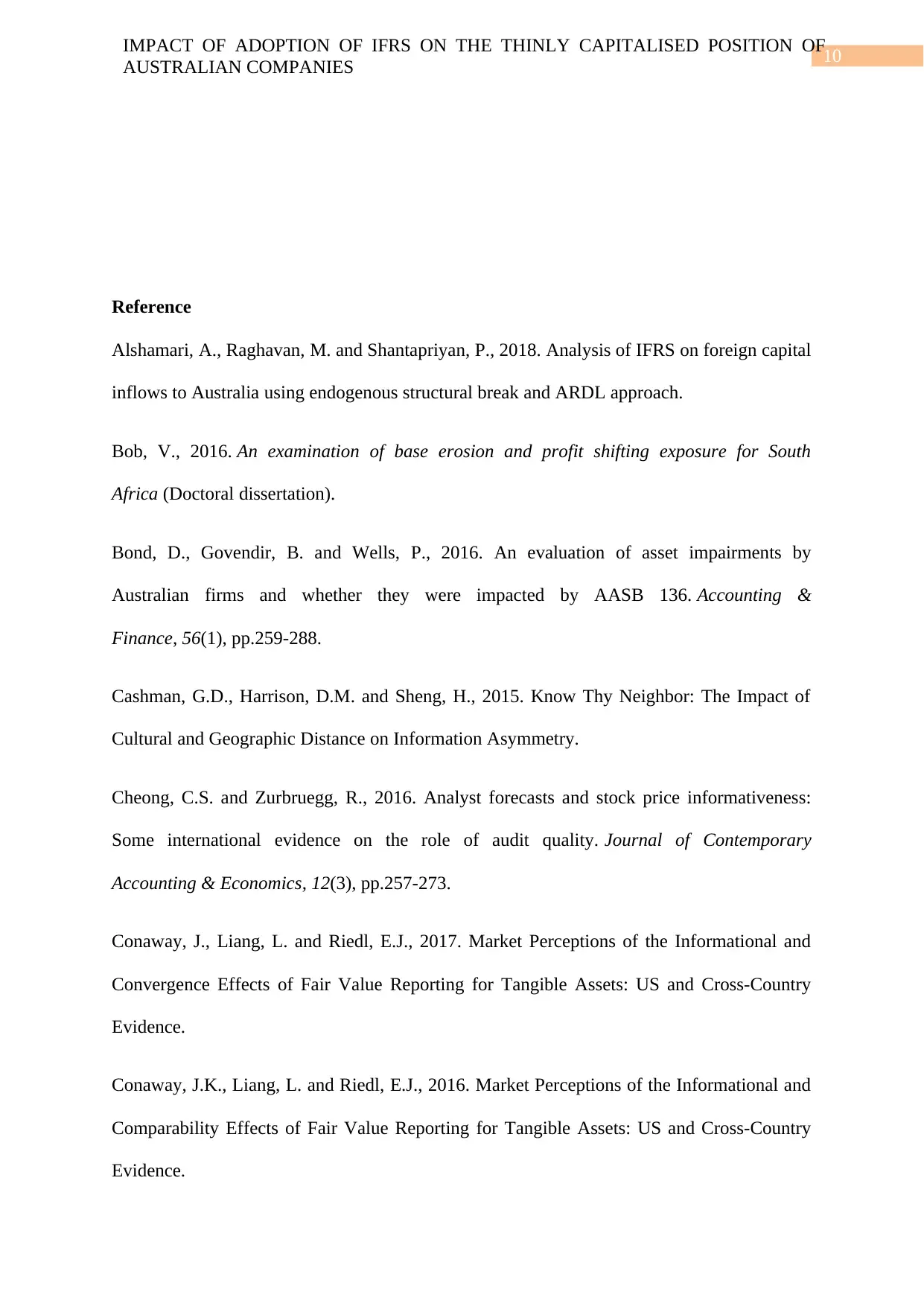
10
IMPACT OF ADOPTION OF IFRS ON THE THINLY CAPITALISED POSITION OF
AUSTRALIAN COMPANIES
Reference
Alshamari, A., Raghavan, M. and Shantapriyan, P., 2018. Analysis of IFRS on foreign capital
inflows to Australia using endogenous structural break and ARDL approach.
Bob, V., 2016. An examination of base erosion and profit shifting exposure for South
Africa (Doctoral dissertation).
Bond, D., Govendir, B. and Wells, P., 2016. An evaluation of asset impairments by
Australian firms and whether they were impacted by AASB 136. Accounting &
Finance, 56(1), pp.259-288.
Cashman, G.D., Harrison, D.M. and Sheng, H., 2015. Know Thy Neighbor: The Impact of
Cultural and Geographic Distance on Information Asymmetry.
Cheong, C.S. and Zurbruegg, R., 2016. Analyst forecasts and stock price informativeness:
Some international evidence on the role of audit quality. Journal of Contemporary
Accounting & Economics, 12(3), pp.257-273.
Conaway, J., Liang, L. and Riedl, E.J., 2017. Market Perceptions of the Informational and
Convergence Effects of Fair Value Reporting for Tangible Assets: US and Cross-Country
Evidence.
Conaway, J.K., Liang, L. and Riedl, E.J., 2016. Market Perceptions of the Informational and
Comparability Effects of Fair Value Reporting for Tangible Assets: US and Cross-Country
Evidence.
IMPACT OF ADOPTION OF IFRS ON THE THINLY CAPITALISED POSITION OF
AUSTRALIAN COMPANIES
Reference
Alshamari, A., Raghavan, M. and Shantapriyan, P., 2018. Analysis of IFRS on foreign capital
inflows to Australia using endogenous structural break and ARDL approach.
Bob, V., 2016. An examination of base erosion and profit shifting exposure for South
Africa (Doctoral dissertation).
Bond, D., Govendir, B. and Wells, P., 2016. An evaluation of asset impairments by
Australian firms and whether they were impacted by AASB 136. Accounting &
Finance, 56(1), pp.259-288.
Cashman, G.D., Harrison, D.M. and Sheng, H., 2015. Know Thy Neighbor: The Impact of
Cultural and Geographic Distance on Information Asymmetry.
Cheong, C.S. and Zurbruegg, R., 2016. Analyst forecasts and stock price informativeness:
Some international evidence on the role of audit quality. Journal of Contemporary
Accounting & Economics, 12(3), pp.257-273.
Conaway, J., Liang, L. and Riedl, E.J., 2017. Market Perceptions of the Informational and
Convergence Effects of Fair Value Reporting for Tangible Assets: US and Cross-Country
Evidence.
Conaway, J.K., Liang, L. and Riedl, E.J., 2016. Market Perceptions of the Informational and
Comparability Effects of Fair Value Reporting for Tangible Assets: US and Cross-Country
Evidence.
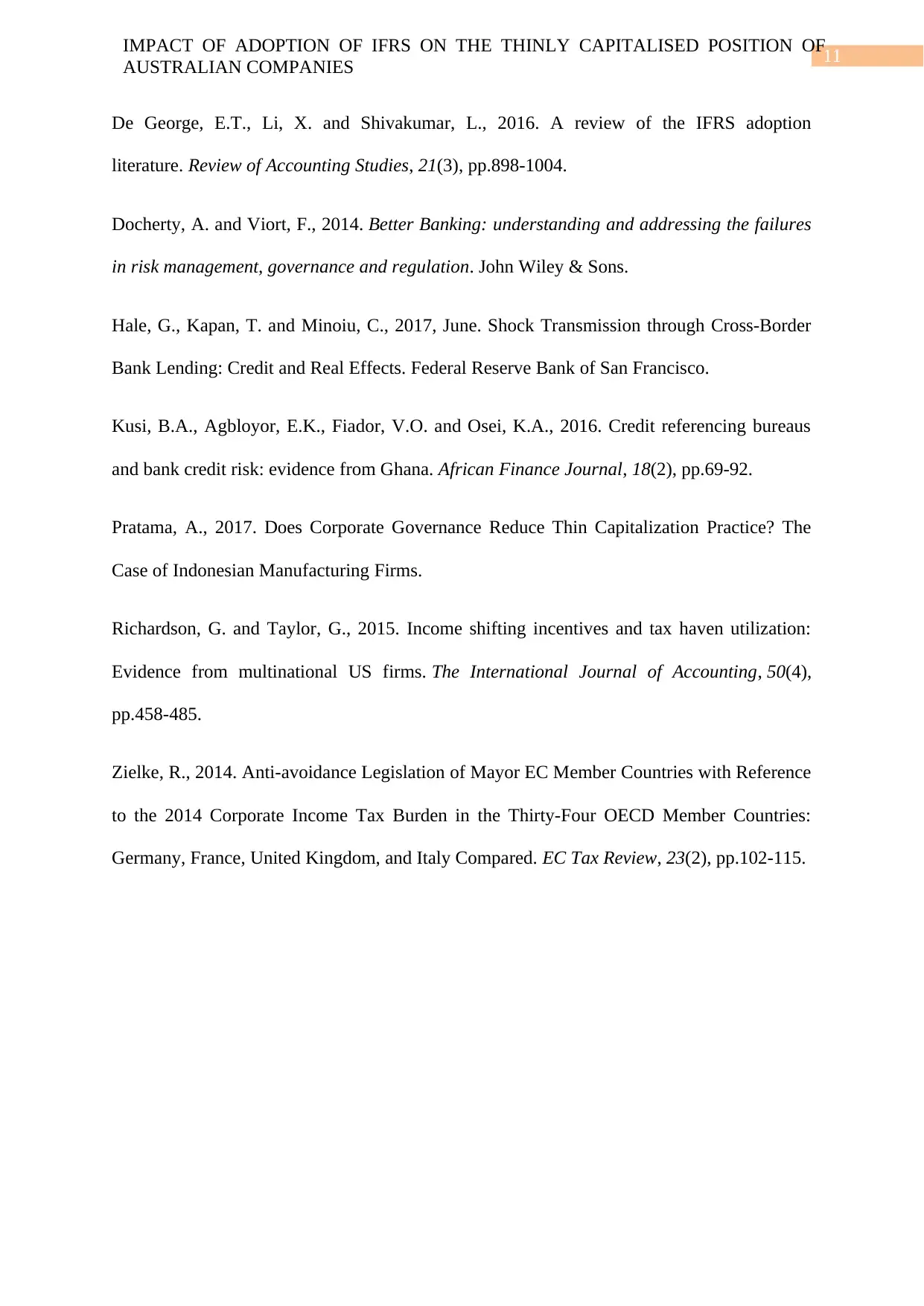
11
IMPACT OF ADOPTION OF IFRS ON THE THINLY CAPITALISED POSITION OF
AUSTRALIAN COMPANIES
De George, E.T., Li, X. and Shivakumar, L., 2016. A review of the IFRS adoption
literature. Review of Accounting Studies, 21(3), pp.898-1004.
Docherty, A. and Viort, F., 2014. Better Banking: understanding and addressing the failures
in risk management, governance and regulation. John Wiley & Sons.
Hale, G., Kapan, T. and Minoiu, C., 2017, June. Shock Transmission through Cross-Border
Bank Lending: Credit and Real Effects. Federal Reserve Bank of San Francisco.
Kusi, B.A., Agbloyor, E.K., Fiador, V.O. and Osei, K.A., 2016. Credit referencing bureaus
and bank credit risk: evidence from Ghana. African Finance Journal, 18(2), pp.69-92.
Pratama, A., 2017. Does Corporate Governance Reduce Thin Capitalization Practice? The
Case of Indonesian Manufacturing Firms.
Richardson, G. and Taylor, G., 2015. Income shifting incentives and tax haven utilization:
Evidence from multinational US firms. The International Journal of Accounting, 50(4),
pp.458-485.
Zielke, R., 2014. Anti-avoidance Legislation of Mayor EC Member Countries with Reference
to the 2014 Corporate Income Tax Burden in the Thirty-Four OECD Member Countries:
Germany, France, United Kingdom, and Italy Compared. EC Tax Review, 23(2), pp.102-115.
IMPACT OF ADOPTION OF IFRS ON THE THINLY CAPITALISED POSITION OF
AUSTRALIAN COMPANIES
De George, E.T., Li, X. and Shivakumar, L., 2016. A review of the IFRS adoption
literature. Review of Accounting Studies, 21(3), pp.898-1004.
Docherty, A. and Viort, F., 2014. Better Banking: understanding and addressing the failures
in risk management, governance and regulation. John Wiley & Sons.
Hale, G., Kapan, T. and Minoiu, C., 2017, June. Shock Transmission through Cross-Border
Bank Lending: Credit and Real Effects. Federal Reserve Bank of San Francisco.
Kusi, B.A., Agbloyor, E.K., Fiador, V.O. and Osei, K.A., 2016. Credit referencing bureaus
and bank credit risk: evidence from Ghana. African Finance Journal, 18(2), pp.69-92.
Pratama, A., 2017. Does Corporate Governance Reduce Thin Capitalization Practice? The
Case of Indonesian Manufacturing Firms.
Richardson, G. and Taylor, G., 2015. Income shifting incentives and tax haven utilization:
Evidence from multinational US firms. The International Journal of Accounting, 50(4),
pp.458-485.
Zielke, R., 2014. Anti-avoidance Legislation of Mayor EC Member Countries with Reference
to the 2014 Corporate Income Tax Burden in the Thirty-Four OECD Member Countries:
Germany, France, United Kingdom, and Italy Compared. EC Tax Review, 23(2), pp.102-115.
⊘ This is a preview!⊘
Do you want full access?
Subscribe today to unlock all pages.

Trusted by 1+ million students worldwide
1 out of 12
Related Documents
Your All-in-One AI-Powered Toolkit for Academic Success.
+13062052269
info@desklib.com
Available 24*7 on WhatsApp / Email
![[object Object]](/_next/static/media/star-bottom.7253800d.svg)
Unlock your academic potential
Copyright © 2020–2025 A2Z Services. All Rights Reserved. Developed and managed by ZUCOL.





